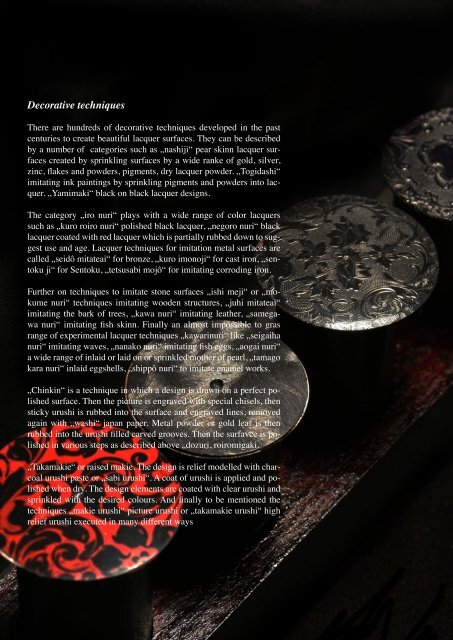Angular Momentum of Switzerland
Angular Momentum of Switzerland
Angular Momentum of Switzerland
You also want an ePaper? Increase the reach of your titles
YUMPU automatically turns print PDFs into web optimized ePapers that Google loves.
Decorative techniques<br />
There are hundreds <strong>of</strong> decorative techniques developed in the past<br />
centuries to create beautiful lacquer surfaces. They can be described<br />
by a number <strong>of</strong> categories such as „nashiji“ pear skinn lacquer surfaces<br />
created by sprinkling surfaces by a wide ranke <strong>of</strong> gold, silver,<br />
zinc, flakes and powders, pigments, dry lacquer powder. „Togidashi“<br />
imitating ink paintings by sprinkling pigments and powders into lacquer.<br />
„Yamimaki“ black on black lacquer designs.<br />
The category „iro nuri“ plays with a wide range <strong>of</strong> color lacquers<br />
such as „kuro roiro nuri“ polished black lacquer, „negoro nuri“ black<br />
lacquer coated with red lacquer which is partially rubbed down to suggest<br />
use and age. Lacquer techniques for imitation metal surfaces are<br />
called „seidô mitateai“ for bronze, „kuro imonoji“ for cast iron, „sentoku<br />
ji“ for Sentoku, „tetsusabi mojô“ for imitating corroding iron.<br />
Further on techniques to imitate stone surfaces „ishi meji“ or „mokume<br />
nuri“ techniques imitating wooden structures, „juhi mitateai“<br />
imitating the bark <strong>of</strong> trees, „kawa nuri“ imitating leather, „samegawa<br />
nuri“ imitating fish skinn. Finally an almost impossible to gras<br />
range <strong>of</strong> experimental lacquer techniques „kawarinuri“ like „seigaiha<br />
nuri“ imitating waves, „nanako nuri“ imitating fish eggs, „aogai nuri“<br />
a wide range <strong>of</strong> inlaid or laid on or sprinkled mother <strong>of</strong> pearl, „tamago<br />
kara nuri“ inlaid eggshells, „shippô nuri“ to imitate enamel works.<br />
„Chinkin“ is a technique in which a design is drawn on a perfect polished<br />
surface. Then the picture is engraved with special chisels, then<br />
sticky urushi is rubbed into the surface and engraved lines, removed<br />
again with „washi“ japan paper. Metal powder or gold leaf is then<br />
rubbed into the urushi filled carved grooves. Then the surfavce is polished<br />
in various steps as described above „dozuri, roiromigaki.<br />
„Takamakie“ or raised makie. The design is relief modelled with charcoal<br />
urushi paste or „sabi urushi“. A coat <strong>of</strong> urushi is applied and polished<br />
when dry. The design elements are coated with clear urushi and<br />
sprinkled with the desired colours. And finally to be mentioned the<br />
techniques „makie urushi“ picture urushi or „takamakie urushi“ high<br />
relief urushi executed in many different ways



